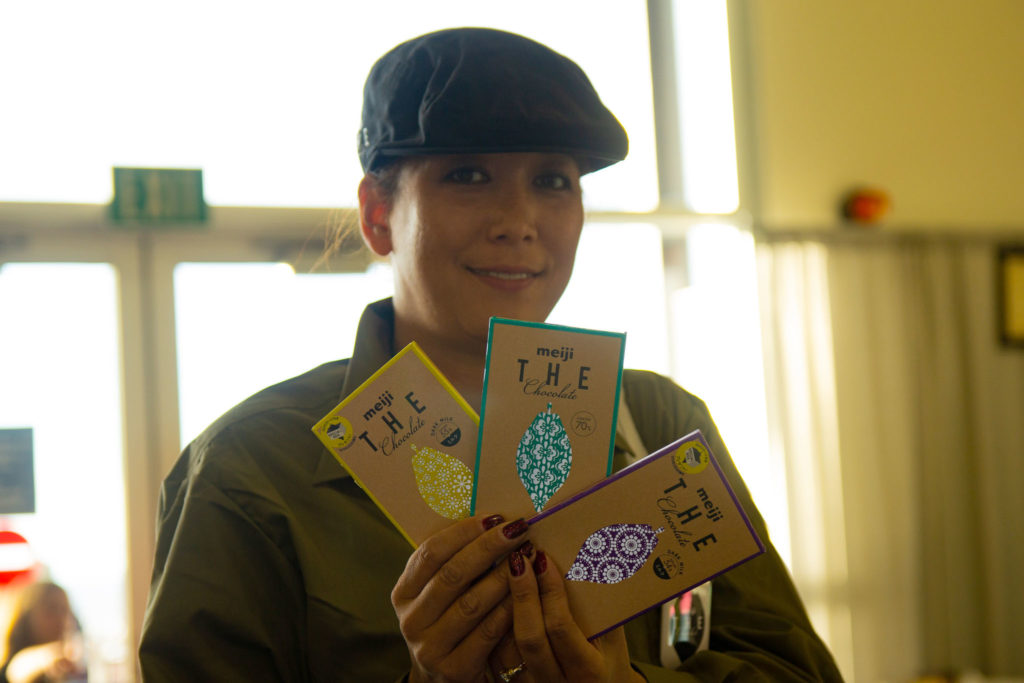In Love with the Cocoa: Northwest Chocolate Festival
Meij THE Chocolate was one of the many companies that sent chocolate connoisseurs to the Northwest Chocolate Festival.
Tucked at the end of Smith Cove Waterway, the Northwest Chocolate Festival attracted thousands of chocolate connoisseurs, companies, and fans this past weekend.
“I think that the culinary world, in general, is about sharing experiences,” Jaime Lutz, a chef at Hot Cakes, said. “Sharing your paths together and what inspires you. I think [chocolate is] a great way to convey your personal experiences with someone else.”
Hot Cakes was one of the more than 150 companies featured at this festival. Among them was a mix of local brands—such as Deviant Chocolate and Intrigue Chocolate Company—as well as international companies like Hogarth Chocolate from New Zealand and Nayah from Brazil. In a stark contrast, familiar brands, such as Fran’s Chocolates and Almond Roca, seemed to draw less of a crowdcompared to the unique independent booths.
“Whimsy Chocolate’s chai meltaway truffles were good,” Jenelle Ho, a first-year at Seattle University, said.
Ho is from Oahu, Hawaii, a state that is typically not known for its chocolate. This may be changing, as there were three chocolate companies—Madre Chocolate, Waialua Estate Coffee and Chocolate, Manoa Chocolate—from the archipelago featured.
The Northwest Chocolate Festival offered more than just chocolate bars. There were booths selling chocolate perfume, cocoa lotion, and rose and chocolate infused black tea. For many, this expanded traditional beliefs over what cacao can be used for.
“I didn’t realize that there were different types of tea-infused chocolate and other types of chocolate,” Ho said.
Despite these differences, many of the booths offered similar products, such as single origin 72 percent cacao from Ecuador and spiced dark chocolate bars. The main difference between these chocolate companies was how they chose to present their booths.
Some groups went for the farm aspect, highlighting their direct trade roots and going as far as to wear straw hats. Others went for the culinary approach, wearing stiff buttoned up chef coats, donning serious faces and serving nothing containing less than 62 percent cacao. This was an anomaly, as more companies catered towards families and teaching a new generation about the intricacies of the chocolate world. Kids could be seen weaving in and out of adults brandishing rum infused chocolate squares, wearing yellow and pink wolf masks, the symbol for the Icelandic company of OmNom Chocolate.
“All of our bars are made in-house by us,” Anya Sullivan, a server at Indi Chocolate, said. “We source our cacao directly from farmers.”
This is a sentiment that many of the companies shared, which may indicate the movement of the chocolate world to shifting focus from pure profits to a sustainable ecosystem. This appreciation for supporting historically undervalued communities is a change from the approach that commercial brands— such as Mars or Nestle—use. In recent years, studies conducted by BBC and the World Cocoa Foundation have found that, despite increasing interest in chocolate, sustainable practices are not following similar trends in popularity.
Most notably is the brand J Coco, a side branch of the popular Seattle Chocolate companywhich sells several products at Seattle U. J Coco started the campaign #chocolatefightshunger, which aims to provide a meal for every chocolate bar sold. However, this campaign is not represented in any of Seattle Chocolate’s other products.
“I think any kind of food has a unifying effect on people,” Sullivan said. “Chocolate especially is something that everyone has pretty heavy memories of.”
With the increase of direct trade chocolate companies at the Northwest Chocolate Festival, people were able to enjoy a guilt-free treat. Chocolate is universal, almost every culture has their own interpretation of the sweet. While Spain is widely known for their drinking chocolate, Switzerland is home to creamy truffles, and Latin America is widely accredited for the invention of cayenne and cinnamon spiced chocolate.
Instead of planning a trip, you can start trying new types of chocolate. You do not have to go to a special fair to try single origin, direct trade chocolate. Whole Foods offers a vast array of chocolate brands and Intrigue Chocolate & Coffee House is a mere 15-minute walk from Seattle U’s campus. Be sure to check the chocolate bar’s label for certification of their direct trade status.
Taylor may be reached at
[email protected]




